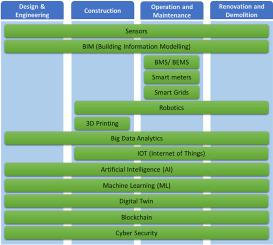当前位置:
X-MOL 学术
›
J. Clean. Prod.
›
论文详情
Our official English website, www.x-mol.net, welcomes your feedback! (Note: you will need to create a separate account there.)
Digitalization for sustainable buildings: Technologies, applications, potential, and challenges
Journal of Cleaner Production ( IF 11.1 ) Pub Date : 2024-03-21 , DOI: 10.1016/j.jclepro.2024.141814 Muhammad Asif , Ghinwa Naeem , Muhammad Khalid
Journal of Cleaner Production ( IF 11.1 ) Pub Date : 2024-03-21 , DOI: 10.1016/j.jclepro.2024.141814 Muhammad Asif , Ghinwa Naeem , Muhammad Khalid

|
In the fight against climate change, and to improve its sustainability standards, the building sector is trying to reduce its energy consumption and environmental footprint. Leveraging digitalization, in the wake of Industry 4.0 and 5.0, holds immense potential in revolutionizing the buildings and construction sector. Digitalization is transforming buildings throughout their life cycle encompassing design, construction, operation, and retrofitting/decommissioning stages. This study aims to analyze the role of digital technologies in sustainable buildings. In doing so, a systematic literature review is conducted to examine the current landscape of the application of 13 key digital technologies - sensors, Building information modeling (BIM), Building Management Systems (BMS), smart meters, 3D printing/additive manufacturing, robotics, big data analytics, Internet of Things (IoT), machine learning, artificial intelligence, digital twin, blockchain, and cyber security - in terms of their scope and prospects in the building sector. These technologies have been discussed considering their functions, applications in buildings, adoption and market trends, challenges, and the way forward. The findings of the study reveal that digital technologies are making buildings more integrated, flexible, energy-efficient, smart, and sustainable by optimizing resource utilization, enhancing operational efficiency, and minimizing environmental impact. For instance, sensors enable real-time data collection, BIM facilitates sustainability assessments, and AI enhances energy management. Further, digital technologies can lead to a 30%–50% improvement in energy intensity in the building sector by 2040. While digital technologies offer promising solutions in terms of improving sustainability standards in buildings, they also face several challenges such as high initial cost, privacy and security risks associated with data breaches and cyber-attacks, and lack of customer awareness and a skilled workforce. Conducive policies and regulations are critical for creating an enabling environment that supports the adoption of digital technologies.
中文翻译:

可持续建筑的数字化:技术、应用、潜力和挑战
在应对气候变化和提高可持续性标准的过程中,建筑行业正在努力减少能源消耗和环境足迹。继工业 4.0 和 5.0 之后,利用数字化在彻底改变建筑行业方面具有巨大潜力。数字化正在改变建筑物的整个生命周期,包括设计、施工、运营和改造/退役阶段。本研究旨在分析数字技术在可持续建筑中的作用。为此,我们进行了系统的文献综述,以研究 13 种关键数字技术的应用现状 - 传感器、建筑信息模型 (BIM)、建筑管理系统 (BMS)、智能电表、3D 打印/增材制造、机器人技术、大数据分析、物联网 (IoT)、机器学习、人工智能、数字孪生、区块链和网络安全 - 就其在建筑领域的范围和前景而言。对这些技术的讨论考虑了它们的功能、在建筑中的应用、采用和市场趋势、挑战和未来的发展方向。研究结果表明,数字技术通过优化资源利用、提高运营效率和最大限度地减少环境影响,使建筑变得更加集成、灵活、节能、智能和可持续。例如,传感器支持实时数据收集,BIM 促进可持续性评估,AI 增强能源管理。此外,到 2040 年,数字技术可以使建筑行业的能源强度降低 30%–50%。虽然数字技术在提高建筑可持续性标准方面提供了有前途的解决方案,但它们也面临着一些挑战,例如初始成本高、与数据泄露和网络攻击相关的隐私和安全风险,以及缺乏客户意识和熟练的劳动力。有利的政策和法规对于创造支持数字技术采用的有利环境至关重要。
更新日期:2024-03-21
中文翻译:

可持续建筑的数字化:技术、应用、潜力和挑战
在应对气候变化和提高可持续性标准的过程中,建筑行业正在努力减少能源消耗和环境足迹。继工业 4.0 和 5.0 之后,利用数字化在彻底改变建筑行业方面具有巨大潜力。数字化正在改变建筑物的整个生命周期,包括设计、施工、运营和改造/退役阶段。本研究旨在分析数字技术在可持续建筑中的作用。为此,我们进行了系统的文献综述,以研究 13 种关键数字技术的应用现状 - 传感器、建筑信息模型 (BIM)、建筑管理系统 (BMS)、智能电表、3D 打印/增材制造、机器人技术、大数据分析、物联网 (IoT)、机器学习、人工智能、数字孪生、区块链和网络安全 - 就其在建筑领域的范围和前景而言。对这些技术的讨论考虑了它们的功能、在建筑中的应用、采用和市场趋势、挑战和未来的发展方向。研究结果表明,数字技术通过优化资源利用、提高运营效率和最大限度地减少环境影响,使建筑变得更加集成、灵活、节能、智能和可持续。例如,传感器支持实时数据收集,BIM 促进可持续性评估,AI 增强能源管理。此外,到 2040 年,数字技术可以使建筑行业的能源强度降低 30%–50%。虽然数字技术在提高建筑可持续性标准方面提供了有前途的解决方案,但它们也面临着一些挑战,例如初始成本高、与数据泄露和网络攻击相关的隐私和安全风险,以及缺乏客户意识和熟练的劳动力。有利的政策和法规对于创造支持数字技术采用的有利环境至关重要。



























 京公网安备 11010802027423号
京公网安备 11010802027423号